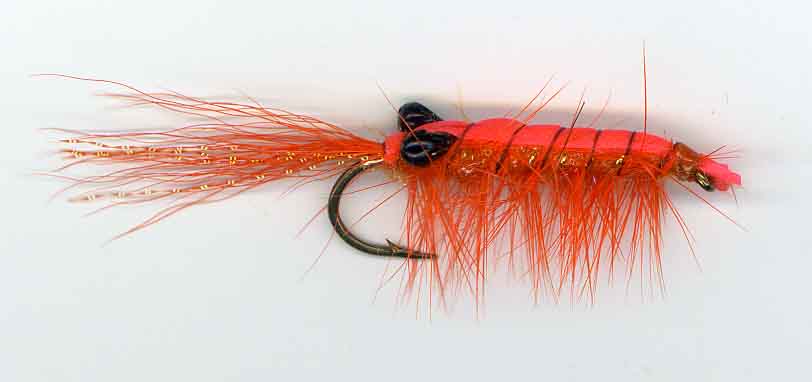Welcome to River Magic
Stillwater Slim on the Line ... October 20, 2009
|
The Ripley Family of Amherst and Lester the Lobster
Lester the Lobster, a wet fly for fall-run Atlantic salmon, proved more than 2 decades ago that he’s not just a pretty fly with a cute name, but a very effective shrimp pattern. Lester’s popularity has been spreading recently and local fly shops can’t produce them fast enough to satisfy demand. It seems that its sleek shape has aero-dynamic properties that make casting and fishing the fly an angler’s delight, and very attractive to salmon too!
Paul Marriner, in his 1998 Frank Amato publication, Modern Atlantic Salmon Flies, tells the fly’s history. “Lester is the Atlantic salmon version of a British Columbia steelhead pattern, the Squamish Poacher... It first appeared in the east as a trout fly on Prince Edward Island in the late 1980s although it may have taken salmon in the same period from the Morell River. When it arrived on Nova Scotia’s River Phillip in the fall of 1994, in the hands of Brian Gairns of Amherst, NS, it immediately began to outfish the favourite General Practitioner... According to Danny Ripley, owner of fly shop Rip-Tide Tackle Ltd. in Amherst, the fly works with all wet fly techniques. In 1997, when cast across-stream in slack water and retrieved with painfully slow, steady pulls after a downstream mend, it again proved effective.”
Don MacLean, in A Little Thing I Tied Myself, Nimbus, 2006, writes that the late Jack Ripley, Danny’s father, was instrumental in popularizing the fly. Jack was at first sceptical, but soon learned how effective Lester the Lobster is. For example, he tied some for anglers heading to Labrador, where they cleaned up on Arctic char using the fly.
Danny Ripley, with help from his family, founded his family fly shop, Rip-Tide Tackle Ltd. at age 17. Since then, Danny has become a fish habitat biologist and project manager for the Cumberland County River Enhancement Association (CCREA), a chapter of Trout Unlimited Canada. Danny leads and oversees all aspects of the CCREA's freshwater habitat restoration programs for native brook trout and Atlantic salmon. Rip-Tide also provides office space for the CCREA, and all the staff at Rip-Tide, together with a lot of their customers, are involved in CCREA's projects. Danny believes that “all of us who make any kind of living from our natural resources, or enjoy them, have an implied responsibility to enhance, restore, and protect those resources that give us so much, and are an integral part of our lives. If we can't protect it, and stand up for it, no one will.”
Danny’s brother, David, also ties flies for the shop, instructs fly tying classes, and travels to sports shows with the shop, aiding in set up and customer service. Maybe we can learn from the passion and dedication of Danny and his family to restore fishing in Guysborough county waters. Why not?
Lester the Lobster
Thread: UTC G.S.P. 50 Denier red thread Hook: Mustad 9672 wet fly hook, sizes 2-8 Tag: Flat copper tinsel Tail: Orange bucktail and 2-4 strands of orange Krystal Flash Rib #1: 4-pound-test clear mono (wound after all other steps complete) Back: ¼” – 1/8”-wide orange surveyors tape (body size determines width), pulled over body after body hackle & rib Rib#2: Oval copper tinsel Body hackle: Orange, palmered over body Body: Orange Ice Dub tapered from large to small toward hook eye Eyes: Black prawn eyes Head: Red GSP thread finished with 2 coats Angler’s Corner Clear Wet Head Cement
Enjoy your fishing and please stay on the line … |
